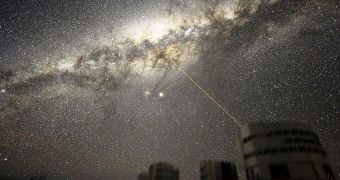A while back, we reported on the chance that cosmic fireworks may soon drench the core of the Milky Way. A gas cloud was observed heading for the supermassive black hole in the center of the galaxy, and its collision with the dark behemoth was bound to cause a firework show of sorts. Now, astronomers determined the origins of the gas cloud.
At first, experts led by Stefan Gillessen – at the Max Planck Institute for Extraterrestrial Physics, in Garching, Germany – who first discovered the object, said it was simply a gas cloud that had somehow made its way towards the inner regions of the galaxy.
But a subsequent analysis, conducted by experts at the Harvard-Smithsonian Center for Astrophysics (CFA), in Cambridge, shows that the gas most likely originated in the protoplanetary disk around a star that used to lie very close to Sagittarius A*.
CFA investigators, Ruth Murray-Clay and Abraham Loeb, believe that the disk was heavily disrupted following some sort of natural catastrophe, and that the black hole is simply drawing the gas towards its event horizon. The entire cloud weighs about three times the mass of Earth.
The most important implication of the new research is that planets can form at the galactic core, in a brutal environment where numerous stars orbit in close proximity to each other. Until just recently, this was thought to be nearly impossible,
“This cloud of gas naturally originates from a protoplanetary disk surrounding a low-mass star, which was scattered a century ago from the observed ring of young stars orbiting Sgr A*,” the team says.
Astronomers calculate that the gas cloud will reach the event horizon around the black hole by mid-2013. At that time, we can expect to see a brightening of radiations released by Sagittarius A*, as seen in multiple portions of the electromagnetic spectrum.
About 2.7 percent of all stars in the inner sectors of the galaxy should theoretically have habitable planets around them, according to a new computer model, based on the latest available data. However, about three quarters of those should be tidally locked to their stars.
This means that they are so close to their respective stars that they always keep the same face oriented towards them. The same thing happens with the Moon and Earth, with the exception that tidally locked planets are usually located extremely close to their stars, and are therefore rather hot, Daily Galaxy reports.

 14 DAY TRIAL //
14 DAY TRIAL //